African millet – also known as pearl millet, Pennisetum, or feathertop grass – is a popular food crop in African countries. In Europe, African millet is primarily grown as an ornamental plant. Read on to learn about the planting and care rules for this beautiful grass.
Table of contents
What Is African Millet?
Pennisetum, or feathertop grass, is a member of the Poaceae family, widely grown in tropical and subtropical climates. In temperate European climates, it is cultivated as an annual.
Note. Due to its decorative appearance, African millet is becoming increasingly popular among European gardeners. However, growing Pennisetum in moderate climates is challenging because the plant cannot survive frosty winters.
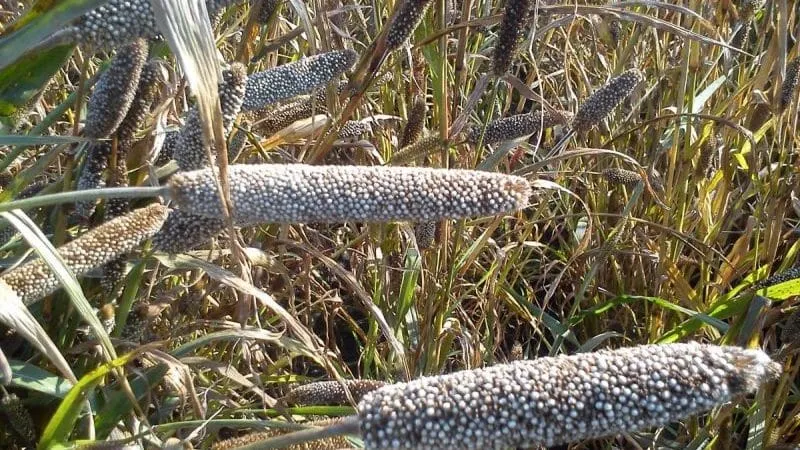
Description and Characteristics of Pennisetum Glaucum
Pennisetum is a herbaceous grass that can reach up to 4 m in height under optimal conditions. Its roots can penetrate the soil up to 3.5 m deep, though most are found within the top 10 cm.
The leaves of African millet are dark green. The inflorescences are dense, spike-like panicles about 20 cm long. Each spikelet consists of 9 florets with hairy axes and short bristles. Flowering occurs from July to September.
Each seedhead contains thousands of small grains, about 5 mm in diameter, which can be white, yellow, red, or black.
Note. The grass can be propagated by seeds or cuttings. Seeds are sown in open ground in early May or started indoors in mid-April.
Varieties and Types
The most popular types of African millet include:
- Pennisetum alopecuroides (Fountain Grass). This variety can survive winters in milder European regions. It forms a broad bush, 40 cm to 1 m tall, with narrow green leaves that turn yellow in autumn. Flowering occurs from August to September (or July for dwarf varieties). The inflorescences are fluffy panicles ranging from creamy white to reddish-brown. Native to East Asia and Australia.
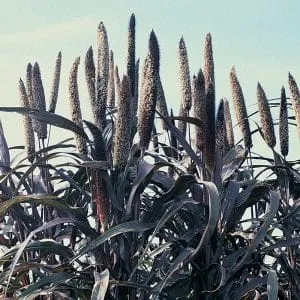
- Pennisetum orientale. A perennial grass that grows naturally on rocky slopes in subtropical regions of Asia and Africa. Stems reach 15–80 cm, with dense, spike-like panicles 4–15 cm long, colored pinkish-brown. It can only overwinter in frost-free areas.
- Pennisetum villosum. A perennial native to East Africa, growing on mountain slopes. It forms dense clumps 30–60 cm tall, with golden cylindrical panicles (3–10 cm long). Flowers appear in August, usually in the second year. Suitable for southern European climates.
- Pennisetum incomptum. A cold-resistant species from China, growing in mountainous areas. Forms large clumps up to 1.2 m tall, with green or grey-green foliage. Flowers from late June to September, changing from greenish to yellow-brown. Its rhizomes can be invasive.
- Pennisetum glaucum (Pearl Millet). Valued for its bronze-colored, broad leaves (up to 3.5 cm wide). Grows up to 2 m tall. Primarily a food and fodder crop, but also grown ornamentally in Europe. Fast-growing, typically treated as an annual in colder climates.
Popular Pennisetum glaucum cultivars:
- Purple Majesty – Entire plant, including panicles, has a purple-bronze hue.
- Jester – Late-flowering variety, up to 120 cm tall.
- Purple Baron – Reaches 1 m, with purple stems and inflorescences.
- Purple Magic – Red-leaved, up to 1.5 m, with upright purple panicles.
- Jade Princess – Grows 0.9–1.2 m, with bright green foliage and burgundy spikelets.
Economic Uses
African millet is highly nutritious and productive. A single plant can yield up to 15 seedheads.
It is used to make flatbreads, porridge, and fermented beverages similar to beer.
The stems and leaves serve as livestock fodder, either fresh or dried as hay.
Note. Dried Pennisetum stems make attractive decorative elements in vases.
Feathertop grass is widely used in landscaping. Dwarf varieties edge flower beds, fences, and pathways, while tall cultivars create living hedges.
Note. In colder regions, perennial varieties should be grown in containers and overwintered indoors.
Historical Background
Pennisetum has been cultivated in Africa for over 3,000 years. It later spread to Asia, thriving in India and Myanmar, where it is still grown in arid tropical highlands (800–1,800 m above sea level).
Nutritional Composition and Health Benefits
The grains are highly nutritious and long-lasting. They contain: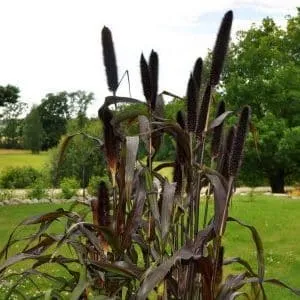
- Carbohydrates – 56–76%;
- Protein – 9–16%;
- Fats – 4–6%;
- Ash – 2–7%.
Rich in essential nutrients:
- Minerals – phosphorus, magnesium, zinc, copper, iodine;
- Vitamins – pantothenic acid, folate, niacin.
Note. African millet has the highest niacin content among cereals.
Caloric value: 350 kcal per 100 g.
Health Benefits
Due to its nutrient density, millet is a valuable dietary component with therapeutic properties. It is often included in medicinal diets.
Effects on Health
Benefits of African millet:
- Detoxifies the body thanks to its fiber content;
- Acts as a diuretic, reducing edema;
- Supports nervous system function via folate;
- Improves cardiovascular health due to potassium.
Growing Guide for Open Ground
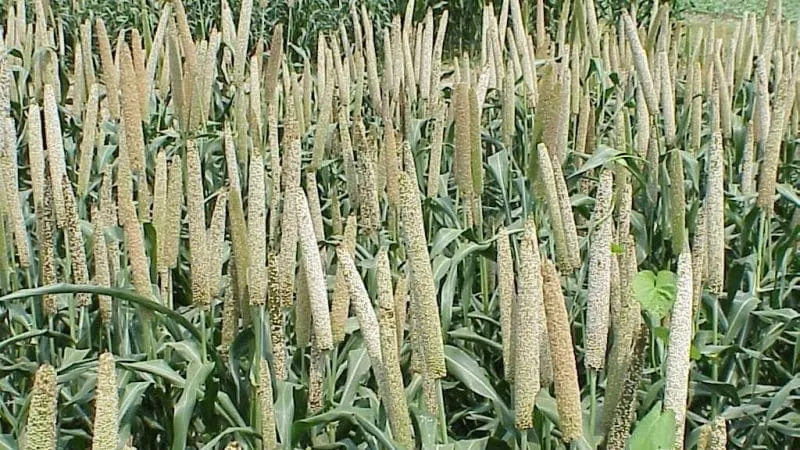
Pennisetum can be grown from seeds (annuals) or cuttings (perennials).
Proper cultivation ensures healthy plants.
Sow annuals in pots in spring and transplant outdoors by May. Alternatively, sow directly in early May under protective film.
Site Selection
The plant thrives in full sun. Choose a sheltered, well-lit spot, such as along fences or walls.
Important. Mature plants should not be kept in greenhouses.
Soil Preparation
Prefers fertile, moist soil with pH 5.5–7.0.
Prepare the site by weeding, tilling, and leveling. Loosen soil to 10–15 cm depth.
Note. Fertilize with phosphorus, potassium, and nitrogen. Reapply nitrogen after a month.
Seed Treatment
Remove seed coats to improve germination. For frost resistance, sort and pre-soak seeds.
Planting Technique
In gardens, sow manually—5–6 seeds per hole, spaced 45 cm apart. Commercial planting uses seed drills with 100 cm row spacing.
Note. In Africa and India, seedlings are grown in nurseries for a month before transplanting.
Transplant seedlings (15 cm tall) after the last frost.
Pest and Disease Control
Rarely affected, but potential issues include:
- Rust (fungal) – Treat with fungicides and transplant if soil is waterlogged.
- Scale insects – Use soap spray, fern extract, or permethrin-based products.
- Aphids – Apply soap solution or Pyrethrum.
Important. Overwatering causes stem rot—reduce irrigation if signs appear.
Maintenance
Care involves:
- Soil aeration (2–3 times per season);
- Hand-weeding (critical in early growth);
- Hilling tall varieties;
- Irrigation (4+ sessions in dry summers);
- Fertilization (NPK minerals or manure).
Note. Recommended fertilizers: Crystallon, Plantafol, Ammophos.
Expert Tips
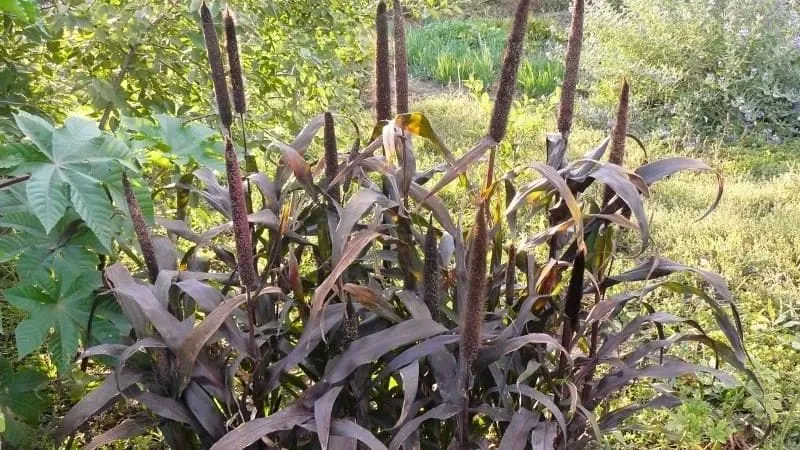
Avoid waterlogged soil—ensure good drainage.
For winter-hardy perennials, leave foliage intact as insulation. Mulch roots with leaves, then prune dead growth in spring.
Note. Pennisetum complements water features and flower beds. Its cascading leaves pair well with Caltha palustris or Cotula coronopifolia.
Conclusion
African millet is a drought-resistant, low-maintenance ornamental grass, ideal for solo or mixed plantings in European gardens.







